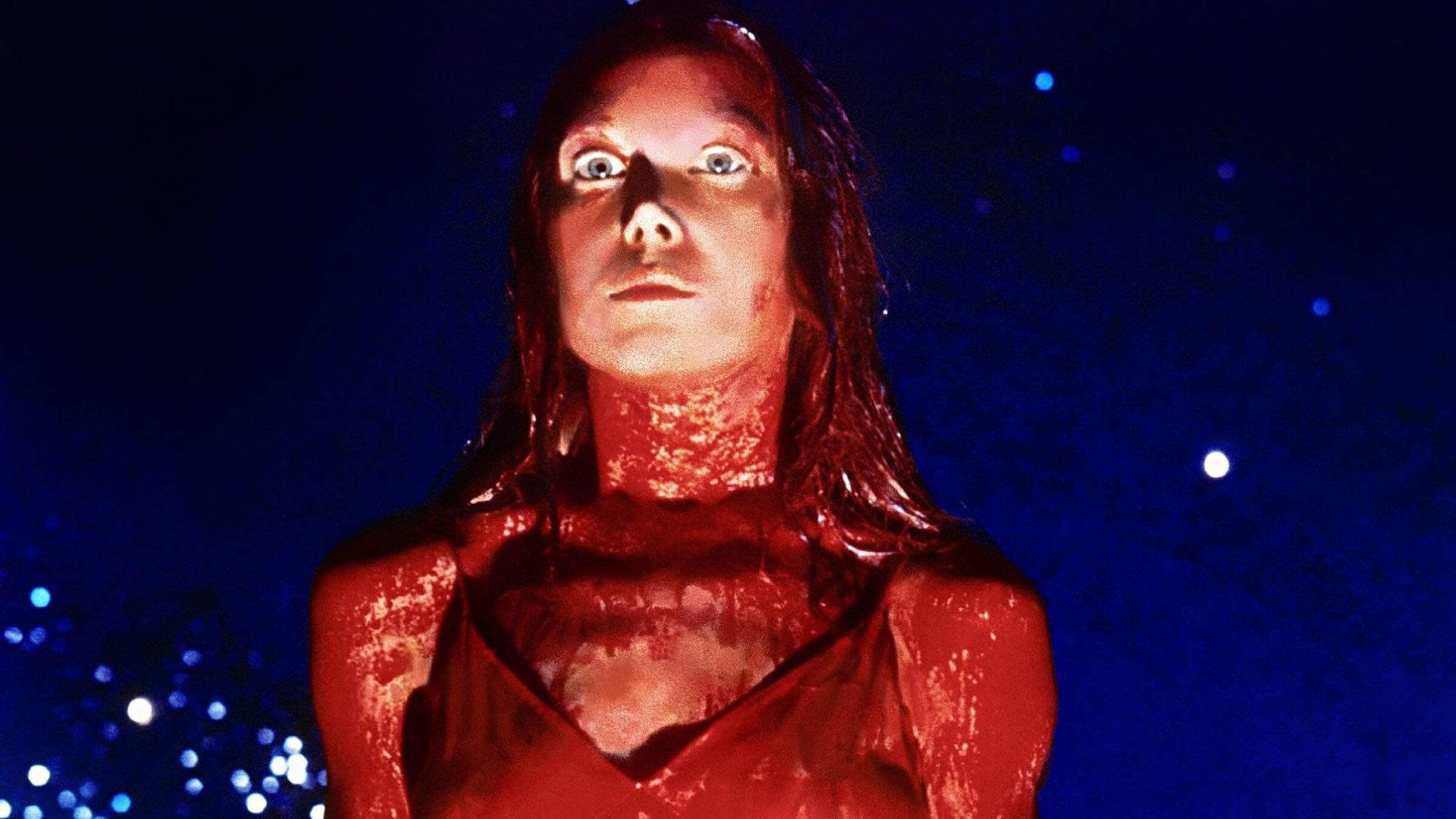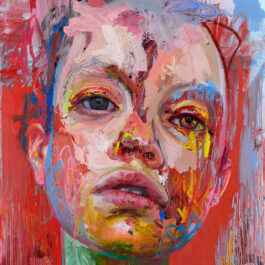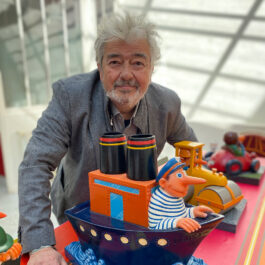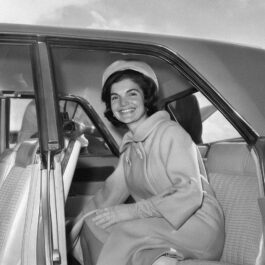For over four decades, Stephen King has been a giant of horror literature, writing numerous bestsellers and amassing an army of devoted fans. In that time, many of his works have also been adapted into films, with some becoming classics of cinema while others faded into obscurity.
We sat down with King expert Dr. Charlie Allbright, whose book, Stephen King’s IT: Culture and The Clown, is published this winter, to examine the history of Stephen King stories on film.
Carrie (1976)
Sissy Spacek stars as Carrie, the meek high school outcast whose newly discovered telekinetic powers lead to her wreaking havoc on prom night. The film is based on King’s first published novel, which nearly didn’t see the light of day. “He’d been writing for a while, but basically wrote a few pages, decided he didn’t like it, and threw it in the bin,” Allbright explains. “His wife, Tabitha, fished it out, and the rest is history!”
The image of Spacek covered in blood is an iconic part of horror movie history, although Allbright reveals the book’s take on Carrie is very different. “She’s described as being ‘like a cow’, as in actually looking like one,” he says. “So the film, where you see Sissy Spacek, is completely different! In the film, Carrie is Sissy Spacek with a slight case of shyness.”
He also points out that Carrie’s powers were described very differently in the book. “The word that King uses is ‘flex’. Her abilities are literally portrayed as a developing muscle. In the film, it’s almost something shown as seedy and wrong.”
The Shining (1980)
If you’re a film student, you’re likely to view Stanley Kubrick’s The Shining as a masterpiece of cinema. Many students of King, however, view the film as an abomination that the author himself has expressed disdain for. So why does the cinema version of the events at The Overlook Hotel cause so much controversy?
“The biggest difference is the character of Jack Torrance himself,” Allbright says. “In the book, he’s a teacher, he’s a father, he’s trying to write, he’s trying his best to be a good guy. Part of the reason he goes to The Overlook is because he can’t deal with his role as a teacher. You feel sorry for him.”
“In the film, Jack Nicholson plays Jack Nicholson. From the get-go he’s a snarling idiot. From a narrative point of view, it means you never get that arc. The book is a tragedy, because the whole time you’re willing Jack to be able to get himself together and beat the hotel, but he never does.”
Firestarter (1984)
A star-studded cast including Martin Sheen and George C. Scott star in this story of a little girl (a young Drew Barrymore) who is hunted by a government agency because of her powers of telekinesis.
The film flopped at the box office, with many critics pointing to the poor characterisation of Barrymore’s character as a major flaw. Allbright agrees, pointing out that “the difference I really noticed is that in the book there’s a lot more emphasis on the way she feels. She can start fires when she’s angry, for example. There’s one or two incidents where she hurts people and feels terrible about it afterwards. In the film, she’s seen as being a bit of a brat occasionally.”
Stand By Me (1986)
A beloved ‘80s classic, this nostalgia-filled story is based on King’s novella The Body, but his name didn’t feature heavily in the marketing at the time, as mainstream audiences associated his name with horror.
“The main idea of the book is this continued grief of his childhood, not where the characters end up,” Allbright explains, before arguing that the film (one of King’s favourite adaptations of his work) actually improves on the source material. “I think they improved [on the book] because they cut away the chaff, essentially,” he says. “All the massive plot beats are there, but you can show them very quickly in one scene rather than taking up pages of dialogue. That’s down to the cast being so well-suited for their roles”.
Misery (1990)
The only film based on a Stephen King story to win an Oscar, Kathy Bates won Best Actress for her portrayal of a deranged fan who holds her favourite author (James Caan) hostage. While the infamous ‘hobbling’ scene stole the headlines, Allbright says the terror comes from more than violence: “A lot of the fear of the book is realised by the claustrophobia of the film.”
Stand By Me director Rob Reiner was also behind the camera on this film. “(King) has a set number of directors that he likes working with. In a certain sense, there are people who just ‘get’ what he does.”
The Shawshank Redemption (1994)
This heart-warming prison drama (you don’t hear those words together often!) had its own history: largely ignored upon release in cinemas, it eventually found an audience on home video and has since become widely regarded as one of the greatest films of all time, as well as a favourite of King’s. The novella it’s based on takes a slightly harder tone, with the ending not quite as satisfying as the Hollywood version.
“The main thing the film has is Morgan Freeman, aka ‘The Voice of God’! In the book, Red is actually Irish,” Allbright explains. “[Freeman] impacts the story in a way that’s a lot more hopeful, and gives the film more of a ‘Hollywood ending’. He becomes the saviour character, who tells you everything is going to be OK.”
The Green Mile (1999)
Another prison drama, this time starring Tom Hanks as a prison warden who encounters a death row inmate (Michael Clarke Duncan) with strange powers. “I loved both, genuinely,” Allbright beams, describing it as a film that stays close to the story it’s adapting.
“The book goes into a lot more detail as to the actual killer [who frames John Coffey]. In the book he’s younger, and the details of his crimes get a lot darker. In the film it’s Sam Rockwell, who does a good job. I think the changes they made actually fit quite nicely.”
Dreamcatcher (2003)
The 2000s were a shaky decade for Stephen King adaptations, most notably this disaster about a group of friends who gain powers from an experience when they were younger, later becoming involved in an alien invasion. The film itself was a box office catastrophe, which director Laurence Kasdan (The Empire Strikes Back) claims ‘wounded’ his career. For Allbright, the key to its failure is simple: “it falls apart because it deviates from the story, and becomes a bit of a silly, campy sci-fi.”
1408 (2007)
A more favourably reviewed film was this version of King’s audio short story, starring John Cusack as a writer who stays in a hotel room that begins to invade his mind.
The film is a departure from the original story, considering that Cusack’s character is given a wife and deceased child. While such a deviation might have been seen as a mistake, King has listed it as one of his favourite adaptations, and Allbright agrees. “It works because, to be honest, the short story is a man in a room psyching himself out – is it him going mad, or is it the room?” he explains. “In the film, you’ve got John Cusack who’s got this whole family drama, there’s a lot more included.”
The Dark Tower (2017)
The Dark Tower is a hallowed title among fans of Stephen King’s work, and an undertaking unlike any other. An epic series of eight novels and one short story that have a thread running through almost every King tale. At the centre of it is The Gunslinger, and his quest to reach a tower. The scope and fan base seems perfect for a post-Marvel world, yet the film was a financial flop that left newbies flummoxed and hard-core fans disappointed by the focus on child character Jake (Tom Taylor), relegating The Gunslinger (Idris Elba) to a supporting role.
“In the film, most of the original story and characters are junked! It’s such a shame,” Allbright says with a sigh. “I think if the film had focused far less on the shenanigans of what was happening to Jake, and more on The Gunslinger’s journey, it would have been a better film.” He does, however, commend the film’s casting: “I think it’s perfect,” he says of Elba. “He’s a tough guy actor, who can play an outsider like The Gunslinger. Matthew McConaughey as The Man In Black, I really liked that casting. Because Walter is actually, by nature, quite campy.”
IT: Chapters One and Two (2017 and 2019)
One adaptation that absolutely lived up to expectations was the first film in a two-part adaptation of IT. Despite losing the original director and star, and having to follow up the infamous TV series starring Tim Curry, the story of childhood friends terrorised by a malevolent entity known as IT was adapted successfully by Andy Muschietti (Mama), making over $700 million and setting records for an R-rated movie.
This month the sequel, Chapter Two, sees IT return to terrorise the now grown-up children, played by Jessica Chastain, James McAvoy and Bill Hader, among others. “The big difference between this and the book is that obviously it is the first of two,” Allbright argues. “We don’t yet know how they’re going to deal with the other part of the story, which deals with them as adults.”
An expert on the book and its adaptations, Allbright has his own theories. “What I suspect is they will change how it represents the idea of getting older,” he says. “When he wrote the book, King was coming up to turning 40. Back in those days, 40 was not like it is now. Nowadays people don’t consider 40 to be that old. In the book, there’s a lot made of the fact that (the characters are) going to seed. In the film, you’ve got James McAvoy, Jessica Chastain… they’re all hot! That may change the motivations of the characters in the story, as it’s not as much about ageing.”
For more information on the book Stephen King’s IT: Culture and The Clown, visit drcharlie.blog














Sorry, the comment form is closed at this time.